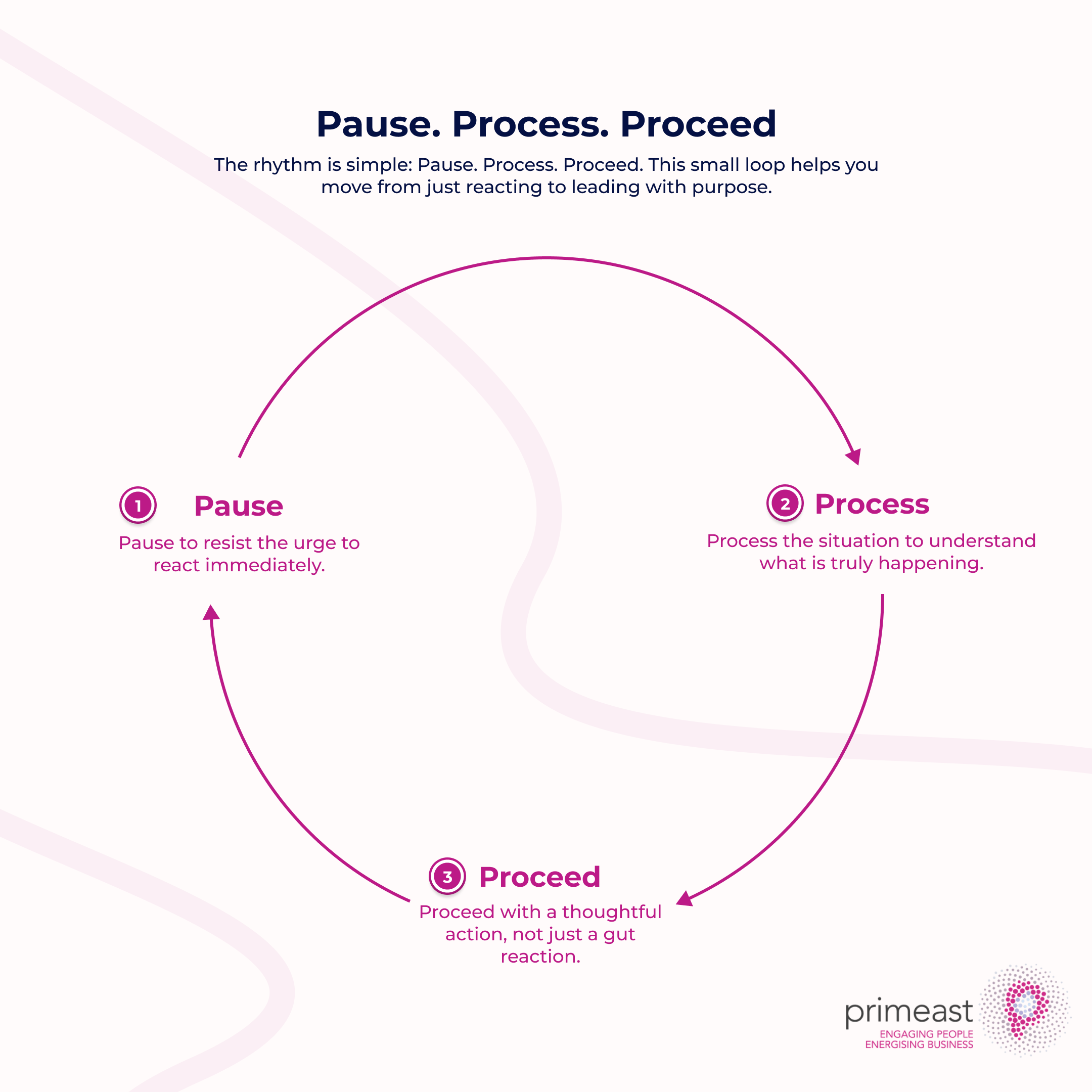
Key Takeaways:
- Reflection Is a Strategic Advantage: This practice delivers clear results, leading to better decisions, stronger team engagement, and a more resilient organisational culture.
- Start Small to Build the Habit: You don’t need hours. A consistent practice can be built in just five minutes a day using simple tools like journaling or asking for feedback.
- The Process Is Simple: True reflective leadership comes down to a straightforward rhythm: Pause to consider your actions, Process what you have learned, and then Proceed with greater purpose and clarity.
What if your best leadership tool isn’t a new strategy, but a mirror?
In a world that prizes constant action, the idea of slowing down to reflect can feel like a counterintuitive luxury. We are rewarded for doing, for acting, for deciding quickly. But this pressure to always be in motion can create blind spots, leading to reactive decisions instead of thoughtful ones.
True leadership isn’t about the next action; it’s about making sure it’s the right action. This is where reflection becomes more than a “soft skill.” It becomes your real advantage; a mindset that changes how you lead, decide, and connect.
What Is Reflective Leadership?
Reflective leadership isn’t a complex theory. It is the simple practice of looking inward before you act outward, of consistently examining your own decisions, beliefs, and behaviours to improve.
We think of it as being built on three pillars: a genuine curiosity about yourself (self-awareness), the willingness to assess your impact on others (introspection), and a commitment to learn from both your successes and your mistakes.
The rhythm is simple: Pause. Process. Proceed. This small loop helps you move from just reacting to leading with purpose.

Why Reflective Leadership Works
The practice of reflection delivers real results that ripple across teams and entire organisations.
1. You Make Better Decisions
Leaders who pause to think an issue through from multiple angles reduce the risk of bias and hasty judgments. It’s not about slowing down progress; it’s about making the kind of ethically sound and effective decisions that benefit everyone.
Actionable Tip: Try a “decision review.” Once a week, spend five minutes looking back at a key decision you made. What was the outcome? Knowing what you know now, what would you do differently?
2. You Become More Adaptable
Reflection is the engine of self-awareness. It helps you understand your own leadership style and identify where you can improve. This awareness is what allows you to learn from past experiences and apply those lessons to new challenges.
Actionable Tip: Use the “5 Whys” technique on a recent leadership moment. Ask yourself “why” you acted a certain way, and then ask “why” four more times to get to the root of your behaviour.
3. Your Team Becomes More Engaged.
Reflective leadership directly improves how teams perform. When leaders model these habits, they inspire a culture of learning and resilience. While specific numbers vary across studies, research has consistently shown a strong correlation between a leader’s self-awareness, a key outcome of reflection, and their team’s engagement and performance.
For example, a study by the Korn Ferry Institute found that companies with strong financial performance tend to have leaders with higher levels of self-awareness.
4. You Build Stronger Relationships
The emotional understanding nurtured through reflection helps you manage your own stress triggers and better navigate team dynamics. When you are more aware of your own state, you can be more empathetic and supportive, which leads to a healthier and more trusting culture.
Simple Frameworks to Guide Your Reflection
While reflection is a personal practice, a simple structure can make it more purposeful.
These models aren’t rigid rules but can be useful guides. For instance, the Harvard Business School model breaks reflection into a four-part cycle of Awareness, Judgment, Action, and Reflection. Another approach, Taggart’s Reflective Thinking Steps, offers a five-step process: Identify challenges, Step Back as an observer, Collect data, Reflect on what it means, and then Act on your insights.
At Primeast, we don’t believe in following theory for its own sake. We help you adapt these ideas to find a practical approach that works for you and your company.
Common Barriers to Reflection (And How to Fix Them)
If reflection is so powerful, why don’t more leaders do it? The reasons are simple: a lack of time and a lack of training.
But overcoming these barriers is simple. It is not about finding more time. It is about making a little space.
Here’s how to get started:
- Start with five minutes. You do not need an hour. A few minutes at the end of the day is enough to build the habit.
- Pair it with a routine. Link reflection to something you already do. Review your day before leaving the office. Think about your week during your Friday coffee.
- Use simple questions. Do not overthink it. Ask yourself: What went well? What would I do differently?
Simple Tools for Daily Reflection
Making reflection a habit is easier with the right tools. These simple, powerful options can help you build a consistent practice:
- Leadership Journals: A simple place to write down decisions, lessons, and feelings.
- SWOT Reviews: Use this to clarify your strengths, weaknesses, opportunities, and threats. It will help you find your blind spots.
- Feedback Loops: Make asking for feedback a normal part of your process. Regularly seek input from your peers and teams.
- Peer Reflection: Share and reflect on leadership stories with others through mentoring and professional networks.
- Coaching Partnerships: A coach provides an outside view you cannot get alone. They ask powerful questions that challenge your thinking. This partnership makes reflection a more focused and effective practice.
How Reflection Shapes Your Future
Companies know that reflection is key to healthy growth. It is a powerful tool for the future. Companies that build reflective leaders gain real advantages: clearer, more ethical decisions; the ability to keep great people; and a stronger, more innovative culture
What if reflection was your biggest advantage this year? It is not just about looking back. It is about getting ready for what comes next.
Take One Step
The mirror is already there. Are you ready to look?
Reflective leadership is a powerful advantage. Leaders who reflect improve themselves and lift up their teams. They build successful, ethical, and engaged companies.
You do not need a perfect plan to begin. You just need a first step.
Our leadership programs help you build reflection as a core skill. We work with you and your teams to lead with clarity and purpose.



